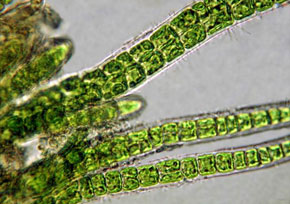Algae & Fungi
What is an algae?

Algae is a term used for aquatic organisms that photosynthesize like land plants yet are structurally less complex and lack vascular tissue (xylem and phloem) found in most plants. Plants that lack these specialized vessels for water transport are called bryophytes (see Plant Kingdom).
All algae contain chlorophyll, however groups differ in the other types of chlorophyll they posses. Algae are commonly grouped taxonomically for the type of pigment they contain; for example, there are yellow-green, golden, brown, red, and green algae.
An example of an algae is the 'Green algae', which are the most diverse and familiar algae in fresh water. Green algae are considered ancestral to land plants, and share many characteristics with land plants, such as: chlorophyll, starch as the carbohydrate storage material, and cell walls made of cellulose. Green algae exhibit a wide variety of forms from single-celled, free-swimming forms (e.g. Chlamydomonas) to motile, colonial forms of various sizes (e.g. Eudorina, Volvox), to multicellular filamentous forms (e.g. Ulothrix).
What is a fungi?

The fungi includes such diverse organisms as mushrooms, molds, puffballs, toadstools, yeast, and Penicillium and are economically important.
At one time fungi were grouped with plants. Later biologists realized that the organisms in the fungi were different from plants in many ways and were placed in their own kingdom. Still, fungi was placed as a closer relative to plants than to animals. Recent molecular data however points to the fungi being more closely related to the choanoflagellates, which are ancestral to animals.
It is believed that all fungi are a monophyletic group that shares the structure of cell walls components made of Chitin (an organic polymer, the same material found in the exoskeleton of insects and crustaceans).
Fungi are heterotrophic and adapted for absorbing food molecules from their environment. They cannot produce their own food by photosynthesis as does plants, nor do they have mouths to ingest organic material, as do animals. Fungi secrete digestive enzymes into their surroundings, which break down complex organic molecules into simpler ones that can be absorbed. Fungi can either be saprophytic (absorb food from dead organic matter) or parasitic (absorb food from the living bodies of other organisms).